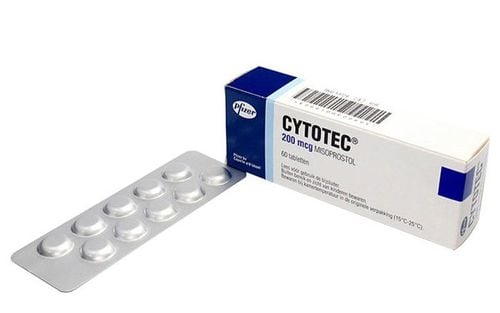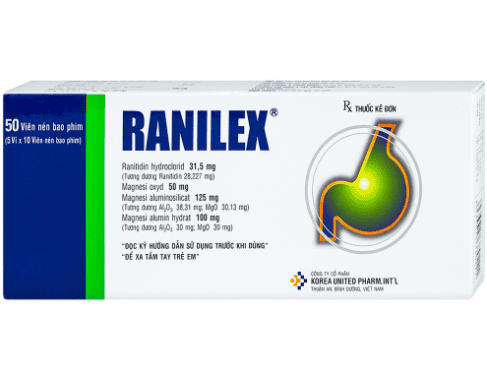This is an automatically translated article.
Pantagi medicine 40mg with the main ingredient is pantoprazole, used in the treatment and prevention of stomach ulcers. However, in the process of use, caution should be exercised in some patients, especially in long-term use.
1. What does Pantagi do?
Pantagi medicine 40mg is a product of Agimexpharm Pharmaceutical Joint Stock Company. The drug is available by prescription and is available in tablet form. Packed in a box of 3 blisters x 10 tablets, when taken, the drug will dissolve in the intestines.
The main ingredient in the drug is Pantoprazole 40mg. Used to treat cases of gastritis - duodenal ulcer, gastric reflux and Helicobacter pylori infection.
Pantagi is indicated to be used in the following cases:
Peptic ulcer. Gastroesophageal reflux, reflux esophagitis. Gastrointestinal ulcers Zollinger-Ellison syndrome, pathological hypersecretion Prevention of gastric ulcers Pharmacodynamics Active ingredient Pantoprazol is a derivative of benzimidazole, which inhibits the secretion of hydrochloric acid in the gastric wall by a single action. specialized on the proton pump in parietal cells. Pantoprazole is converted to the active form in the tubules of parietal cells, inhibiting the enzymes H+, K+ -ATPase. This depends on the dose and the effect on acid secretion. Usually symptoms improve after 2 weeks.
The use of Pantagi can cause a decrease in stomach acid, increasing gastrin in proportion to the decrease in acid.
Pharmacokinetics The active ingredient Pantoprazol in the oral rapidly absorbed drug. The half-life is about 1 hour after oral administration and the bioavailability is about 77%.
The plasma binding rate of pantoprazole is very high (approximately 98%) and is metabolised via the cytochrome P450 system. The metabolites are mainly excreted in the urine (80%) and in the feces (20%). Desmethyl-pantoprazole is a conjugated sulphate - the major product of metabolism, which is usually eliminated after 1.5 hours.
2. Usage and dosage of Pantagi 40mg
Take the pill in the morning, 1 tablet with a large glass of water, do not crush or chew the tablet. If combined treatment for eradication of Helicobacter pylori, the 2nd tablet should be taken before dinner.
Gastro-esophageal reflux: dose 20-40mg once a day for 4 weeks. Gastrointestinal ulcers: dose 40 mg once a day. Treatment is 2-4 weeks for duodenal ulcers and 4-8 weeks for benign gastric ulcers. Eradicate Helicobacter pylori: Combination therapy with Pantoprazol 40mg/2 times/day in combination with clarithromycin 500mg/2 times/day and amoxicillin 1g/2 times/day or metronidazol 400mg/times/day for 1 week. Prevention of ulcers caused by non-steroidal anti-inflammatory drugs: dose 20mg/day. Zollinger - Elliso syndrome: the first dose is 80mg/day - 240mg/day. Doses over 80mg/day should be divided into 2 doses. Patients with liver failure: maximum dose of 20mg/day or 40mg/day used every other day. Patients with renal failure: 40mg/day.
3. Side effects of Pantagi 40mg
Pantoprazole content is well tolerated in short-term and long-term treatment. Here are some side effects when taking Pantagi 40mg:
Common: muscle - joint pain, fatigue, headache, urticaria, skin rash. Uncommon: pruritus, dizziness, asthenia, increased liver enzymes. Rare: malaise, anaphylaxis, peripheral edema and diaphoresis, acne vulgaris, alopecia, angioedema, maculopapular rash, dermatitis, stomatitis, gastrointestinal disorders, belching, insomnia, somnolence, hallucinations, tinnitus, tremors, blurred vision, fear of light, ... With these side effects, absolutely do not arbitrarily use the drug. It is necessary to use the correct dose as prescribed by the doctor.
4. Pantagi 40mg drug interactions
Pantagi can reduce the absorption of other drugs when used together, the absorption depends mainly on pH. Pantoprazole is metabolised in the liver by the cytochrome P450 enzyme system. However, it is not excluded that Pantagi interacts with other drugs metabolized with the same cytochrome P450 enzyme system. However, there have been no trials showing the above-mentioned significant interactions such as oral contraceptives, phenytoin, caffeine, diclofenac, ethanol, metoprolol, warfarin,... In addition, there was no interaction with antacids in treatment. stomach pain, antibiotics used in combination (clarithromycin, metronidazol, amoxicillin) in the treatment of Helicobacter pylori eradication. It is advisable to list all the medications you are taking to your doctor to avoid unwanted interactions between drugs.
5. Notes on drug use
Using high doses and for a long time over 1 year, combined with proton pump inhibitors can cause: fractures of the hip, spine, wrist bone, often occurring in adults. According to research results, proton pump inhibitors can increase the risk of fractures by 10-40%. Therefore, patients at risk of osteoporosis should be examined and guided by the doctor's prescription. In addition, vitamin D and calcium should be added to the body. Treatment with proton pump inhibitors for 3 months to 1 year has been associated with severe hypomagnesaemia. Symptoms occur such as: delirium, spasticity, dizziness, arrhythmia, fatigue, ... In this case, it is necessary to supplement magnesium and stop taking proton pump inhibitors. In addition, magnesium levels should be measured prior to initiating treatment. There have been reports of slight increases in serum ALT and ALT with oral administration. Daily treatment may reduce gastric acid or gastric acidosis. There is no evidence to guarantee effectiveness when used in children under 18 years of age. Women who are pregnant should not take pantoprazole unless clearly needed. If you are breastfeeding, you should stop breastfeeding to avoid potential problems for the baby. Pantagi medicine can cause side effects such as dizziness and visual disturbances... Be careful when driving or operating machinery.
Please dial HOTLINE for more information or register for an appointment HERE. Download MyVinmec app to make appointments faster and to manage your bookings easily.













